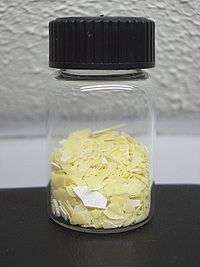Sodium sulfide
 | |
 | |
| Names | |
|---|---|
| Other names
Disodium sulfide | |
| Identifiers | |
| 1313-82-2 1313-84-4 (pentahydrate) 1313-84-4 (nonahydrate) | |
| 3D model (Jmol) | Interactive image |
| ChEBI | CHEBI:76208 |
| ChemSpider | 14120 |
| ECHA InfoCard | 100.013.829 |
| EC Number | 215-211-5 |
| PubChem | 237873 |
| RTECS number | WE1905000 |
| UN number | 1385 (anhydrous) 1849 (hydrate) |
| |
| |
| Properties | |
| Na2S | |
| Molar mass | 78.0452 g/mol (anhydrous) 240.18 g/mol (nonahydrate) |
| Appearance | colorless, hygroscopic solid |
| Odor | rotten eggs |
| Density | 1.856 g/cm3 (anhydrous) 1.58 g/cm3 (pentahydrate) 1.43 g/cm3 (nonohydrate) |
| Melting point | 1,176 °C (2,149 °F; 1,449 K) (anhydrous) 100 °C (pentahydrate) 50 °C (nonahydrate) |
| 12.4 g/100 mL (0 °C) 18.6 g/100 mL (20 °C) 39 g/100 mL (50 °C) | |
| Solubility | insoluble in ether slightly soluble in alcohol |
| Structure | |
| Antifluorite (cubic), cF12 | |
| Fm3m, No. 225 | |
| Tetrahedral (Na+); cubic (S2−) | |
| Hazards | |
| Safety data sheet | ICSC 1047 |
| EU classification (DSD) |
Corrosive (C) Dangerous for the environment (N) |
| R-phrases | R31, R34, R50 |
| S-phrases | (S1/2), S26, S45, S61 |
| NFPA 704 | |
| > 480 °C (896 °F; 753 K) | |
| Related compounds | |
| Other anions |
Sodium oxide Sodium selenide Sodium telluride |
| Other cations |
Lithium sulfide Potassium sulfide |
| Related compounds |
Sodium hydrosulfide |
| Except where otherwise noted, data are given for materials in their standard state (at 25 °C [77 °F], 100 kPa). | |
| | |
| Infobox references | |
Sodium sulfide is the chemical compound with the formula Na2S, or more commonly its hydrate Na2S·9H2O. Both are colorless water-soluble salts that give strongly alkaline solutions. When exposed to moist air, Na2S and its hydrates emit hydrogen sulfide, which smells like rotten eggs. Some commercial samples are specified as Na2S·xH2O, where a weight percentage of Na2S is specified. Commonly available grades have around 60% Na2S by weight, which means that x is around 3. Such technical grades of sodium sulfide have a yellow appearance owing to the presence of polysulfides. These grades of sodium sulfide are marketed as 'sodium sulfide flakes'. Although the solid is yellow, solutions of it are colorless.
Structure
Na2S adopts the antifluorite structure,[1][2] which means that the Na+ centers occupy sites of the fluoride in the CaF2 framework, and the larger S2− occupy the sites for Ca2+.
Production
Industrially Na2S is produced by carbothermic reduction of sodium sulfate often using coal:[3]
- Na2SO4 + 2 C → Na2S + 2 CO2
In the laboratory, the salt can be prepared by reduction of sulfur with sodium in anhydrous ammonia. Alternatively, sulfur can be reduced by sodium in dry THF with a catalytic amount of naphthalene:[4]
- 2 Na + S → Na2S
Sodium sulfide can also be produced by the reaction with sodium cyanide and sulfuric acid, however, extremely toxic hydrogen cyanide is formed in the process.
Reactions with inorganic reagents
The dissolution process can be described as follows:
- S−2 + H2O → HS− + OH−
Sodium sulfide can oxidize when heated to sodium carbonate and sulfur dioxide:
- 2 Na2S + 3 O2 + 2 CO2 → 2 Na2CO3 + 2 SO2
Oxidation with hydrogen peroxide gives sodium sulfate:[5]
- Na2S + 4 H2O2 → 4 H2O + Na2SO4
Upon treatment with sulfur, polysulfides are formed:
- 2 Na2S + S8 → 2 Na2S5
Uses
Sodium sulfide is primarily used in pulp and paper industry in the Kraft process.
It is used in water treatment as an oxygen scavenger agent and also as a metals precipitant, in chemical photography for toning black and white photographs, in textile industry as a bleaching, and as a desulfurising and as a dechlorinating agent and in leather trade for the sulfitisation of tanning extracts. It is used in chemical manufacturing as a sulfonation and sulfomethylation agent. It is used in the production of rubber chemicals, sulfur dyes and other chemical compounds. It is used in other applications including ore flotation, oil recovery, making dyes, and detergent. It is also used for leather processing in liming operation as unhairing agent.
Reagent in organic chemistry
Alkylation of sodium sulfide give thioethers:
- Na2S + 2 RX → R2S + 2 NaX
Even aryl halides participate in this reaction.[6] Sodium sulfide reduces1,3-dinitrobenzene derivatives to the 3-nitroanilines.[7]
Safety
Like sodium hydroxide, sodium sulfide is strongly alkaline and can cause skin burns. Acids react with it to rapidly produce hydrogen sulfide, which is highly toxic.
References
- ↑ Zintl, E; Harder, A; Dauth, B. (1934). "Gitterstruktur der oxyde, sulfide, selenide und telluride des lithiums, natriums und kaliums". Z. Elektrochem. Angew. Phys. Chem. 40: 588–93.
- ↑ Wells, A.F. (1984) Structural Inorganic Chemistry, Oxford: Clarendon Press. ISBN 0-19-855370-6.
- ↑ Holleman, A. F.; Wiberg, E. "Inorganic Chemistry" Academic Press: San Diego, 2001. ISBN 0-12-352651-5.
- ↑ So, J.-H; Boudjouk, P; Hong, Harry H.; Weber, William P. (1992). "Hexamethyldisilathiane". Inorg. Synth. Inorganic Syntheses. 29: 30. doi:10.1002/9780470132609.ch11. ISBN 978-0-470-13260-9.
- ↑ L. Lange, W. Triebel, "Sulfides, Polysulfides, and Sulfanes" in Ullmann's Encyclopedia of Industrial Chemistry 2000, Wiley-VCH, Weinheim. doi:10.1002/14356007.a25_443
- ↑ Charles C. Price, Gardner W. Stacy "p-Aminophenyldisulfide" Org. Synth. 1948, vol. 28, 14. doi:10.15227/orgsyn.028.0014
- ↑ Hartman, W. W.; Silloway, H. L. (1955). "2-Amino-4-nitrophenol". Org. Synth.; Coll. Vol., 3, p. 82
